A study Report on Mental Asylums
VerifiedAdded on 2022/08/10
|19
|4198
|26
AI Summary
Architecture MArch DISSERTATION - 7000 words Topic: The architect's exam with other spaces: A study on Mental asylums -Needs to have a theoretical framework of the research -How does the combination of mental health care and architecture put up to positive mental health results? -Look into Micheal foucault and his perception of mental asylums. -Look into precedents of Mental Asylums in the UK -Talk about power of the confinement spaces -How Foucault explains the relationship between subject and power (government) using the concept of “Other Spaces,”
Contribute Materials
Your contribution can guide someone’s learning journey. Share your
documents today.
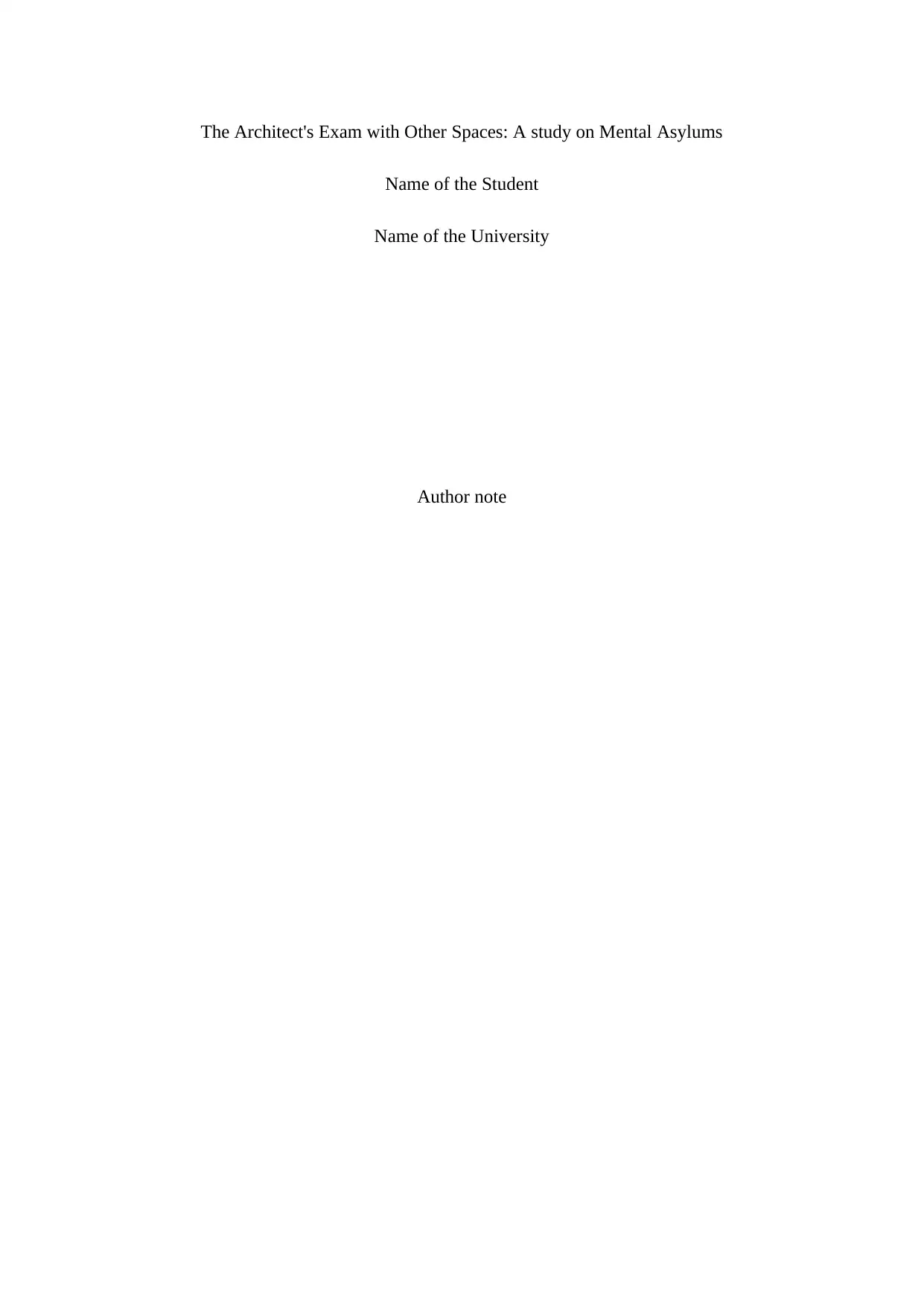
The Architect's Exam with Other Spaces: A study on Mental Asylums
Name of the Student
Name of the University
Author note
Name of the Student
Name of the University
Author note
Secure Best Marks with AI Grader
Need help grading? Try our AI Grader for instant feedback on your assignments.

Abstract
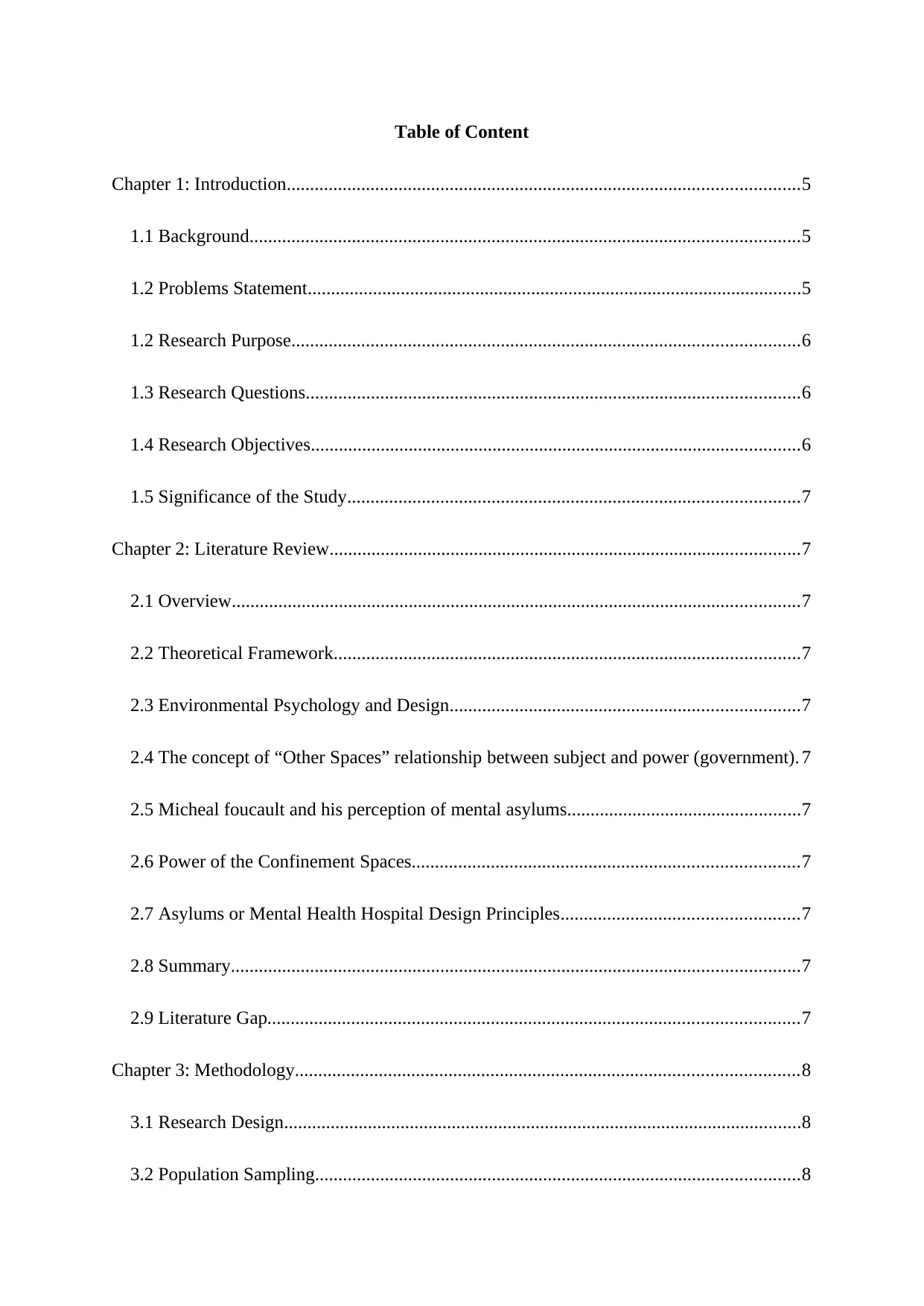
Table of Content
Chapter 1: Introduction..............................................................................................................5
1.1 Background......................................................................................................................5
1.2 Problems Statement..........................................................................................................5
1.2 Research Purpose.............................................................................................................6
1.3 Research Questions..........................................................................................................6
1.4 Research Objectives.........................................................................................................6
1.5 Significance of the Study.................................................................................................7
Chapter 2: Literature Review.....................................................................................................7
2.1 Overview..........................................................................................................................7
2.2 Theoretical Framework....................................................................................................7
2.3 Environmental Psychology and Design...........................................................................7
2.4 The concept of “Other Spaces” relationship between subject and power (government). 7
2.5 Micheal foucault and his perception of mental asylums..................................................7
2.6 Power of the Confinement Spaces...................................................................................7
2.7 Asylums or Mental Health Hospital Design Principles...................................................7
2.8 Summary..........................................................................................................................7
2.9 Literature Gap..................................................................................................................7
Chapter 3: Methodology............................................................................................................8
3.1 Research Design...............................................................................................................8
3.2 Population Sampling........................................................................................................8
Chapter 1: Introduction..............................................................................................................5
1.1 Background......................................................................................................................5
1.2 Problems Statement..........................................................................................................5
1.2 Research Purpose.............................................................................................................6
1.3 Research Questions..........................................................................................................6
1.4 Research Objectives.........................................................................................................6
1.5 Significance of the Study.................................................................................................7
Chapter 2: Literature Review.....................................................................................................7
2.1 Overview..........................................................................................................................7
2.2 Theoretical Framework....................................................................................................7
2.3 Environmental Psychology and Design...........................................................................7
2.4 The concept of “Other Spaces” relationship between subject and power (government). 7
2.5 Micheal foucault and his perception of mental asylums..................................................7
2.6 Power of the Confinement Spaces...................................................................................7
2.7 Asylums or Mental Health Hospital Design Principles...................................................7
2.8 Summary..........................................................................................................................7
2.9 Literature Gap..................................................................................................................7
Chapter 3: Methodology............................................................................................................8
3.1 Research Design...............................................................................................................8
3.2 Population Sampling........................................................................................................8
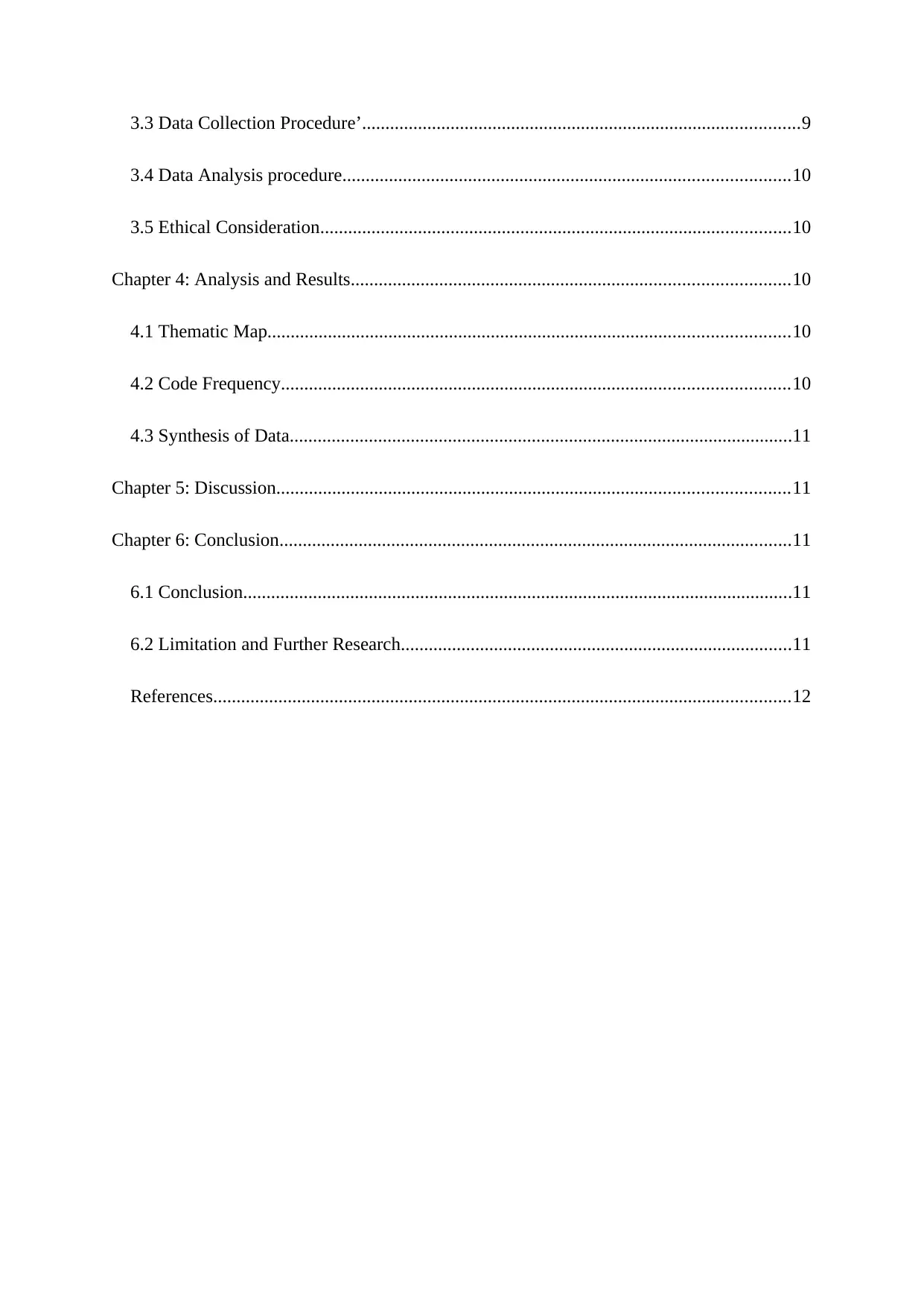
3.3 Data Collection Procedure’..............................................................................................9
3.4 Data Analysis procedure................................................................................................10
3.5 Ethical Consideration.....................................................................................................10
Chapter 4: Analysis and Results..............................................................................................10
4.1 Thematic Map................................................................................................................10
4.2 Code Frequency.............................................................................................................10
4.3 Synthesis of Data............................................................................................................11
Chapter 5: Discussion..............................................................................................................11
Chapter 6: Conclusion..............................................................................................................11
6.1 Conclusion......................................................................................................................11
6.2 Limitation and Further Research....................................................................................11
References............................................................................................................................12
3.4 Data Analysis procedure................................................................................................10
3.5 Ethical Consideration.....................................................................................................10
Chapter 4: Analysis and Results..............................................................................................10
4.1 Thematic Map................................................................................................................10
4.2 Code Frequency.............................................................................................................10
4.3 Synthesis of Data............................................................................................................11
Chapter 5: Discussion..............................................................................................................11
Chapter 6: Conclusion..............................................................................................................11
6.1 Conclusion......................................................................................................................11
6.2 Limitation and Further Research....................................................................................11
References............................................................................................................................12
Secure Best Marks with AI Grader
Need help grading? Try our AI Grader for instant feedback on your assignments.
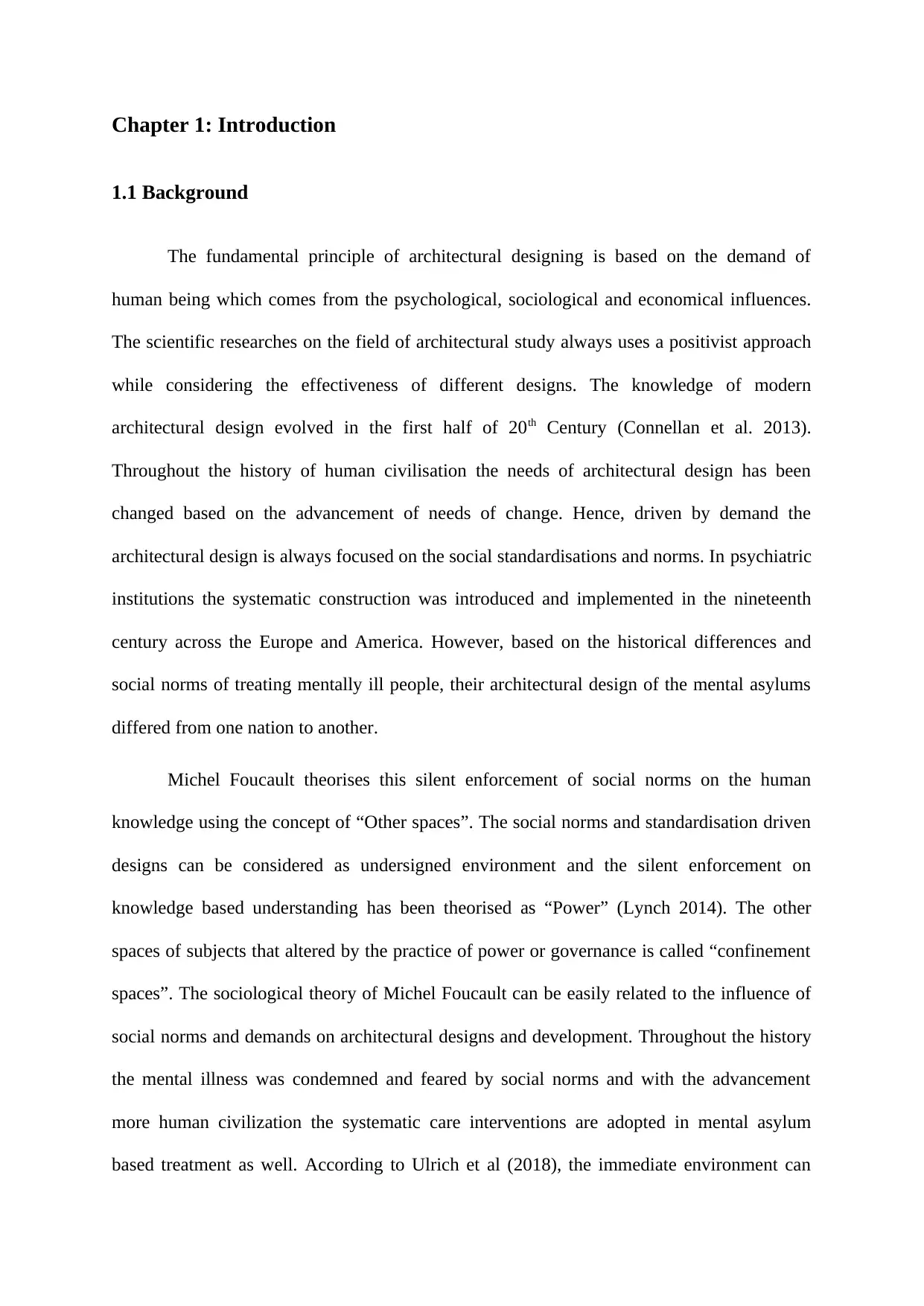
Chapter 1: Introduction
1.1 Background
The fundamental principle of architectural designing is based on the demand of
human being which comes from the psychological, sociological and economical influences.
The scientific researches on the field of architectural study always uses a positivist approach
while considering the effectiveness of different designs. The knowledge of modern
architectural design evolved in the first half of 20th Century (Connellan et al. 2013).
Throughout the history of human civilisation the needs of architectural design has been
changed based on the advancement of needs of change. Hence, driven by demand the
architectural design is always focused on the social standardisations and norms. In psychiatric
institutions the systematic construction was introduced and implemented in the nineteenth
century across the Europe and America. However, based on the historical differences and
social norms of treating mentally ill people, their architectural design of the mental asylums
differed from one nation to another.
Michel Foucault theorises this silent enforcement of social norms on the human
knowledge using the concept of “Other spaces”. The social norms and standardisation driven
designs can be considered as undersigned environment and the silent enforcement on
knowledge based understanding has been theorised as “Power” (Lynch 2014). The other
spaces of subjects that altered by the practice of power or governance is called “confinement
spaces”. The sociological theory of Michel Foucault can be easily related to the influence of
social norms and demands on architectural designs and development. Throughout the history
the mental illness was condemned and feared by social norms and with the advancement
more human civilization the systematic care interventions are adopted in mental asylum
based treatment as well. According to Ulrich et al (2018), the immediate environment can
1.1 Background
The fundamental principle of architectural designing is based on the demand of
human being which comes from the psychological, sociological and economical influences.
The scientific researches on the field of architectural study always uses a positivist approach
while considering the effectiveness of different designs. The knowledge of modern
architectural design evolved in the first half of 20th Century (Connellan et al. 2013).
Throughout the history of human civilisation the needs of architectural design has been
changed based on the advancement of needs of change. Hence, driven by demand the
architectural design is always focused on the social standardisations and norms. In psychiatric
institutions the systematic construction was introduced and implemented in the nineteenth
century across the Europe and America. However, based on the historical differences and
social norms of treating mentally ill people, their architectural design of the mental asylums
differed from one nation to another.
Michel Foucault theorises this silent enforcement of social norms on the human
knowledge using the concept of “Other spaces”. The social norms and standardisation driven
designs can be considered as undersigned environment and the silent enforcement on
knowledge based understanding has been theorised as “Power” (Lynch 2014). The other
spaces of subjects that altered by the practice of power or governance is called “confinement
spaces”. The sociological theory of Michel Foucault can be easily related to the influence of
social norms and demands on architectural designs and development. Throughout the history
the mental illness was condemned and feared by social norms and with the advancement
more human civilization the systematic care interventions are adopted in mental asylum
based treatment as well. According to Ulrich et al (2018), the immediate environment can
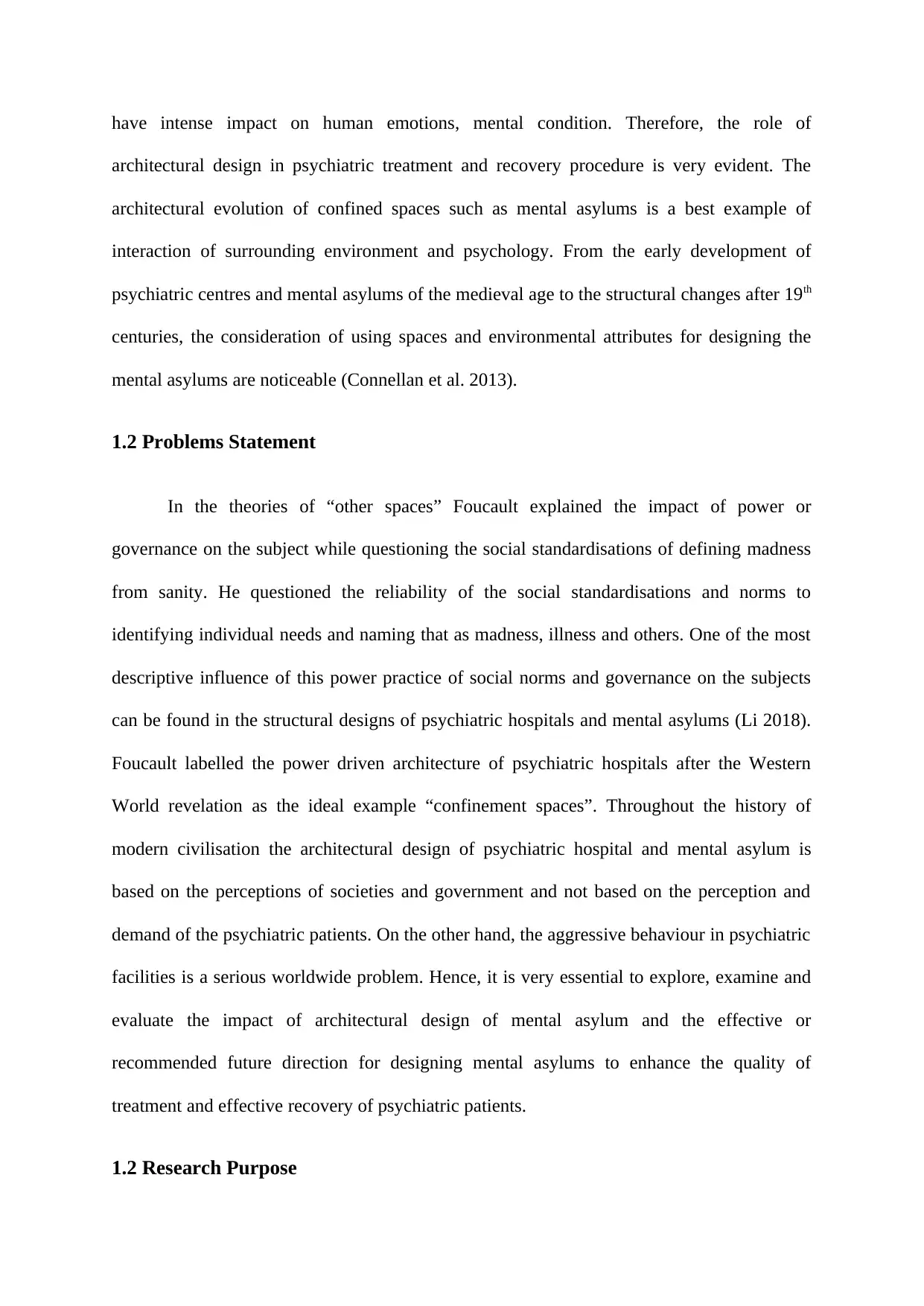
have intense impact on human emotions, mental condition. Therefore, the role of
architectural design in psychiatric treatment and recovery procedure is very evident. The
architectural evolution of confined spaces such as mental asylums is a best example of
interaction of surrounding environment and psychology. From the early development of
psychiatric centres and mental asylums of the medieval age to the structural changes after 19th
centuries, the consideration of using spaces and environmental attributes for designing the
mental asylums are noticeable (Connellan et al. 2013).
1.2 Problems Statement
In the theories of “other spaces” Foucault explained the impact of power or
governance on the subject while questioning the social standardisations of defining madness
from sanity. He questioned the reliability of the social standardisations and norms to
identifying individual needs and naming that as madness, illness and others. One of the most
descriptive influence of this power practice of social norms and governance on the subjects
can be found in the structural designs of psychiatric hospitals and mental asylums (Li 2018).
Foucault labelled the power driven architecture of psychiatric hospitals after the Western
World revelation as the ideal example “confinement spaces”. Throughout the history of
modern civilisation the architectural design of psychiatric hospital and mental asylum is
based on the perceptions of societies and government and not based on the perception and
demand of the psychiatric patients. On the other hand, the aggressive behaviour in psychiatric
facilities is a serious worldwide problem. Hence, it is very essential to explore, examine and
evaluate the impact of architectural design of mental asylum and the effective or
recommended future direction for designing mental asylums to enhance the quality of
treatment and effective recovery of psychiatric patients.
1.2 Research Purpose
architectural design in psychiatric treatment and recovery procedure is very evident. The
architectural evolution of confined spaces such as mental asylums is a best example of
interaction of surrounding environment and psychology. From the early development of
psychiatric centres and mental asylums of the medieval age to the structural changes after 19th
centuries, the consideration of using spaces and environmental attributes for designing the
mental asylums are noticeable (Connellan et al. 2013).
1.2 Problems Statement
In the theories of “other spaces” Foucault explained the impact of power or
governance on the subject while questioning the social standardisations of defining madness
from sanity. He questioned the reliability of the social standardisations and norms to
identifying individual needs and naming that as madness, illness and others. One of the most
descriptive influence of this power practice of social norms and governance on the subjects
can be found in the structural designs of psychiatric hospitals and mental asylums (Li 2018).
Foucault labelled the power driven architecture of psychiatric hospitals after the Western
World revelation as the ideal example “confinement spaces”. Throughout the history of
modern civilisation the architectural design of psychiatric hospital and mental asylum is
based on the perceptions of societies and government and not based on the perception and
demand of the psychiatric patients. On the other hand, the aggressive behaviour in psychiatric
facilities is a serious worldwide problem. Hence, it is very essential to explore, examine and
evaluate the impact of architectural design of mental asylum and the effective or
recommended future direction for designing mental asylums to enhance the quality of
treatment and effective recovery of psychiatric patients.
1.2 Research Purpose
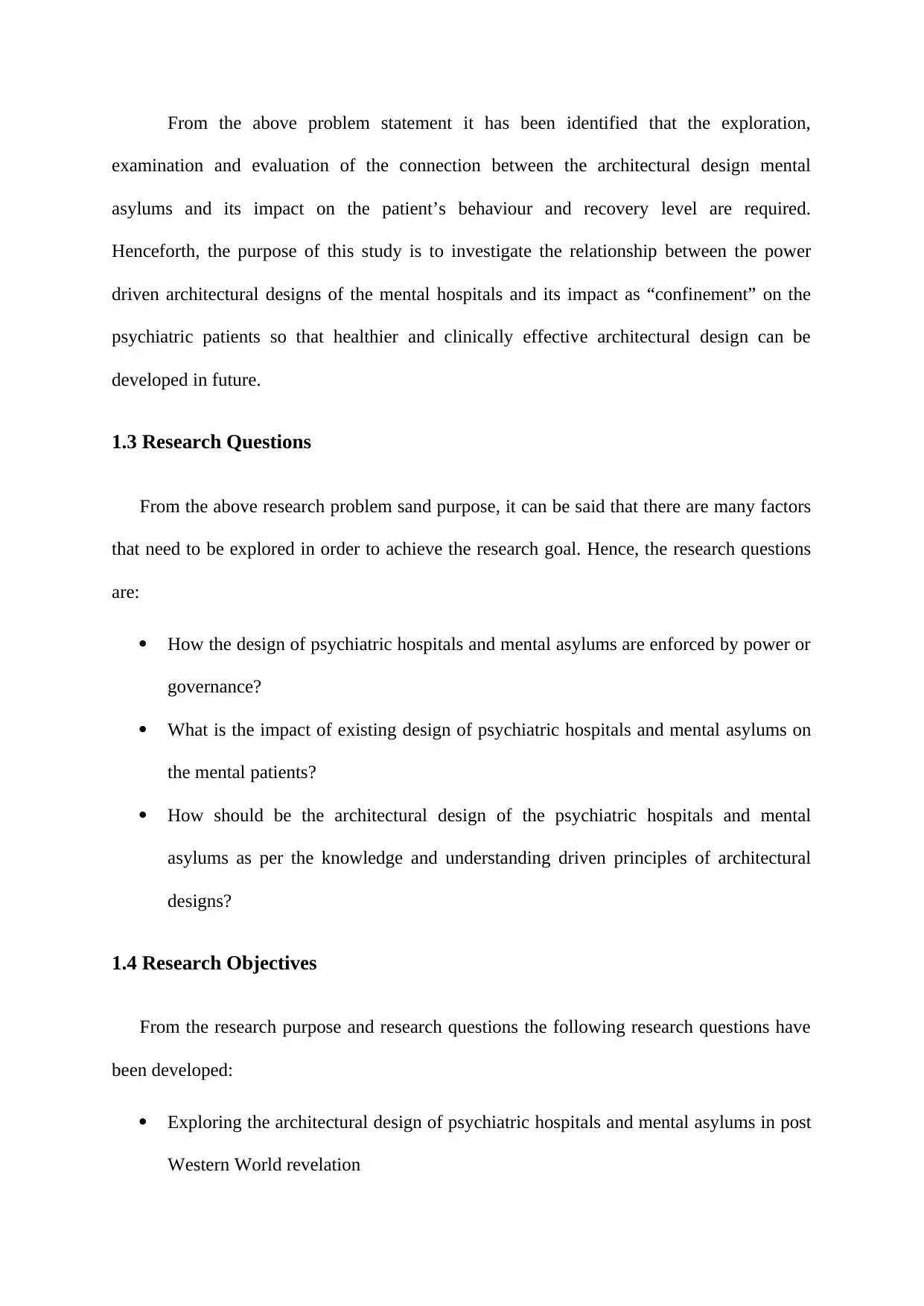
From the above problem statement it has been identified that the exploration,
examination and evaluation of the connection between the architectural design mental
asylums and its impact on the patient’s behaviour and recovery level are required.
Henceforth, the purpose of this study is to investigate the relationship between the power
driven architectural designs of the mental hospitals and its impact as “confinement” on the
psychiatric patients so that healthier and clinically effective architectural design can be
developed in future.
1.3 Research Questions
From the above research problem sand purpose, it can be said that there are many factors
that need to be explored in order to achieve the research goal. Hence, the research questions
are:
How the design of psychiatric hospitals and mental asylums are enforced by power or
governance?
What is the impact of existing design of psychiatric hospitals and mental asylums on
the mental patients?
How should be the architectural design of the psychiatric hospitals and mental
asylums as per the knowledge and understanding driven principles of architectural
designs?
1.4 Research Objectives
From the research purpose and research questions the following research questions have
been developed:
Exploring the architectural design of psychiatric hospitals and mental asylums in post
Western World revelation
examination and evaluation of the connection between the architectural design mental
asylums and its impact on the patient’s behaviour and recovery level are required.
Henceforth, the purpose of this study is to investigate the relationship between the power
driven architectural designs of the mental hospitals and its impact as “confinement” on the
psychiatric patients so that healthier and clinically effective architectural design can be
developed in future.
1.3 Research Questions
From the above research problem sand purpose, it can be said that there are many factors
that need to be explored in order to achieve the research goal. Hence, the research questions
are:
How the design of psychiatric hospitals and mental asylums are enforced by power or
governance?
What is the impact of existing design of psychiatric hospitals and mental asylums on
the mental patients?
How should be the architectural design of the psychiatric hospitals and mental
asylums as per the knowledge and understanding driven principles of architectural
designs?
1.4 Research Objectives
From the research purpose and research questions the following research questions have
been developed:
Exploring the architectural design of psychiatric hospitals and mental asylums in post
Western World revelation
Paraphrase This Document
Need a fresh take? Get an instant paraphrase of this document with our AI Paraphraser
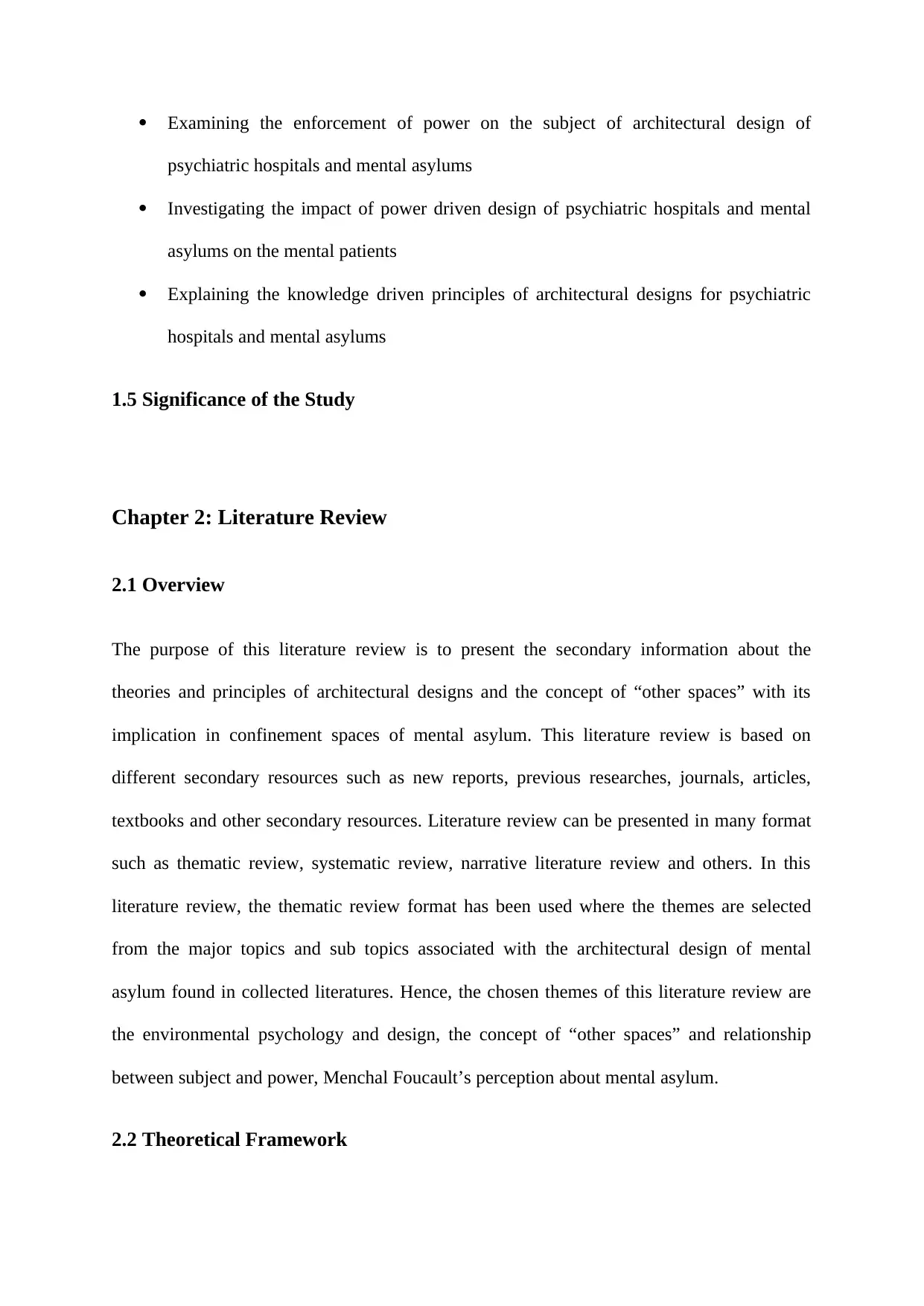
Examining the enforcement of power on the subject of architectural design of
psychiatric hospitals and mental asylums
Investigating the impact of power driven design of psychiatric hospitals and mental
asylums on the mental patients
Explaining the knowledge driven principles of architectural designs for psychiatric
hospitals and mental asylums
1.5 Significance of the Study
Chapter 2: Literature Review
2.1 Overview
The purpose of this literature review is to present the secondary information about the
theories and principles of architectural designs and the concept of “other spaces” with its
implication in confinement spaces of mental asylum. This literature review is based on
different secondary resources such as new reports, previous researches, journals, articles,
textbooks and other secondary resources. Literature review can be presented in many format
such as thematic review, systematic review, narrative literature review and others. In this
literature review, the thematic review format has been used where the themes are selected
from the major topics and sub topics associated with the architectural design of mental
asylum found in collected literatures. Hence, the chosen themes of this literature review are
the environmental psychology and design, the concept of “other spaces” and relationship
between subject and power, Menchal Foucault’s perception about mental asylum.
2.2 Theoretical Framework
psychiatric hospitals and mental asylums
Investigating the impact of power driven design of psychiatric hospitals and mental
asylums on the mental patients
Explaining the knowledge driven principles of architectural designs for psychiatric
hospitals and mental asylums
1.5 Significance of the Study
Chapter 2: Literature Review
2.1 Overview
The purpose of this literature review is to present the secondary information about the
theories and principles of architectural designs and the concept of “other spaces” with its
implication in confinement spaces of mental asylum. This literature review is based on
different secondary resources such as new reports, previous researches, journals, articles,
textbooks and other secondary resources. Literature review can be presented in many format
such as thematic review, systematic review, narrative literature review and others. In this
literature review, the thematic review format has been used where the themes are selected
from the major topics and sub topics associated with the architectural design of mental
asylum found in collected literatures. Hence, the chosen themes of this literature review are
the environmental psychology and design, the concept of “other spaces” and relationship
between subject and power, Menchal Foucault’s perception about mental asylum.
2.2 Theoretical Framework
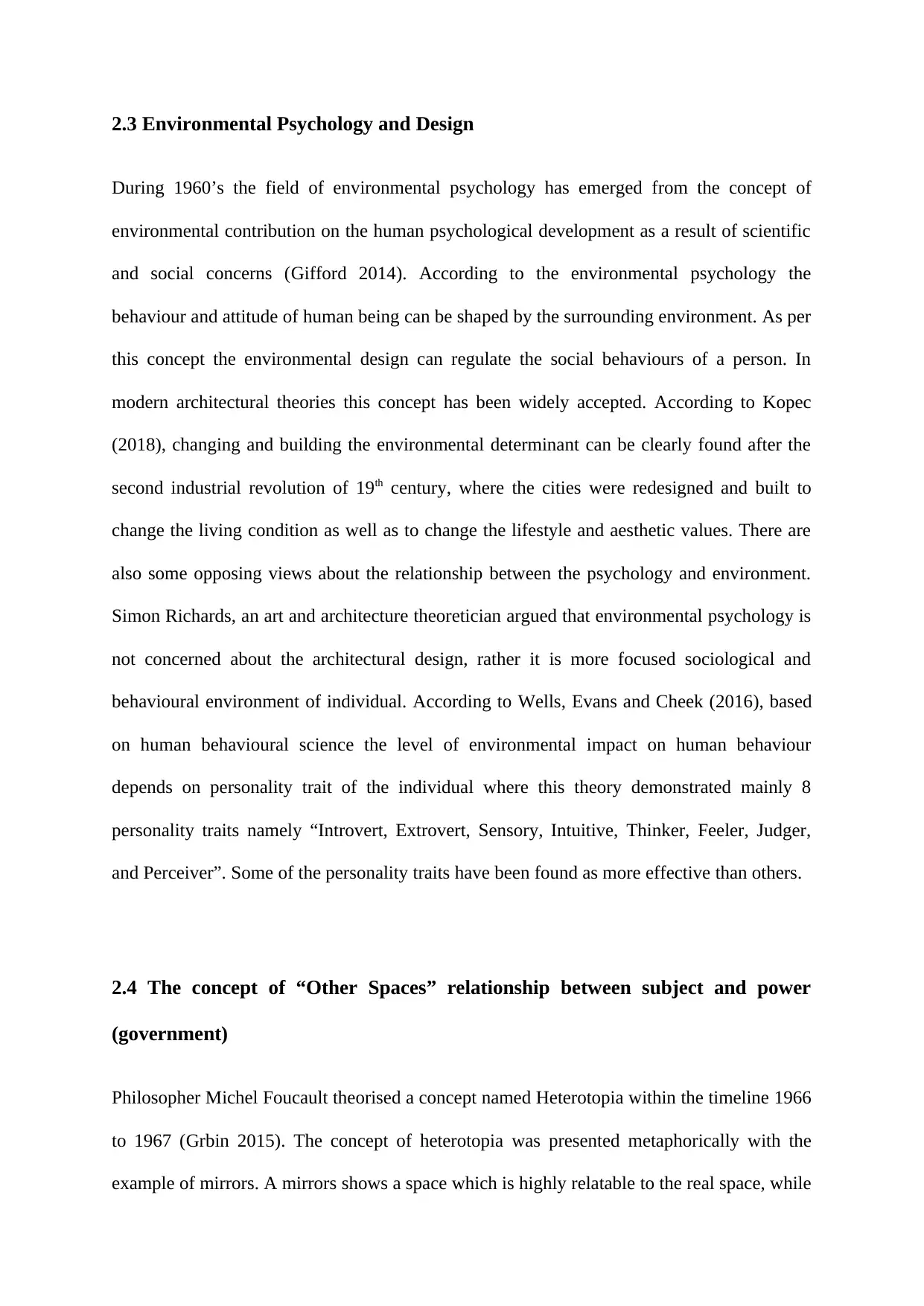
2.3 Environmental Psychology and Design
During 1960’s the field of environmental psychology has emerged from the concept of
environmental contribution on the human psychological development as a result of scientific
and social concerns (Gifford 2014). According to the environmental psychology the
behaviour and attitude of human being can be shaped by the surrounding environment. As per
this concept the environmental design can regulate the social behaviours of a person. In
modern architectural theories this concept has been widely accepted. According to Kopec
(2018), changing and building the environmental determinant can be clearly found after the
second industrial revolution of 19th century, where the cities were redesigned and built to
change the living condition as well as to change the lifestyle and aesthetic values. There are
also some opposing views about the relationship between the psychology and environment.
Simon Richards, an art and architecture theoretician argued that environmental psychology is
not concerned about the architectural design, rather it is more focused sociological and
behavioural environment of individual. According to Wells, Evans and Cheek (2016), based
on human behavioural science the level of environmental impact on human behaviour
depends on personality trait of the individual where this theory demonstrated mainly 8
personality traits namely “Introvert, Extrovert, Sensory, Intuitive, Thinker, Feeler, Judger,
and Perceiver”. Some of the personality traits have been found as more effective than others.
2.4 The concept of “Other Spaces” relationship between subject and power
(government)
Philosopher Michel Foucault theorised a concept named Heterotopia within the timeline 1966
to 1967 (Grbin 2015). The concept of heterotopia was presented metaphorically with the
example of mirrors. A mirrors shows a space which is highly relatable to the real space, while
During 1960’s the field of environmental psychology has emerged from the concept of
environmental contribution on the human psychological development as a result of scientific
and social concerns (Gifford 2014). According to the environmental psychology the
behaviour and attitude of human being can be shaped by the surrounding environment. As per
this concept the environmental design can regulate the social behaviours of a person. In
modern architectural theories this concept has been widely accepted. According to Kopec
(2018), changing and building the environmental determinant can be clearly found after the
second industrial revolution of 19th century, where the cities were redesigned and built to
change the living condition as well as to change the lifestyle and aesthetic values. There are
also some opposing views about the relationship between the psychology and environment.
Simon Richards, an art and architecture theoretician argued that environmental psychology is
not concerned about the architectural design, rather it is more focused sociological and
behavioural environment of individual. According to Wells, Evans and Cheek (2016), based
on human behavioural science the level of environmental impact on human behaviour
depends on personality trait of the individual where this theory demonstrated mainly 8
personality traits namely “Introvert, Extrovert, Sensory, Intuitive, Thinker, Feeler, Judger,
and Perceiver”. Some of the personality traits have been found as more effective than others.
2.4 The concept of “Other Spaces” relationship between subject and power
(government)
Philosopher Michel Foucault theorised a concept named Heterotopia within the timeline 1966
to 1967 (Grbin 2015). The concept of heterotopia was presented metaphorically with the
example of mirrors. A mirrors shows a space which is highly relatable to the real space, while
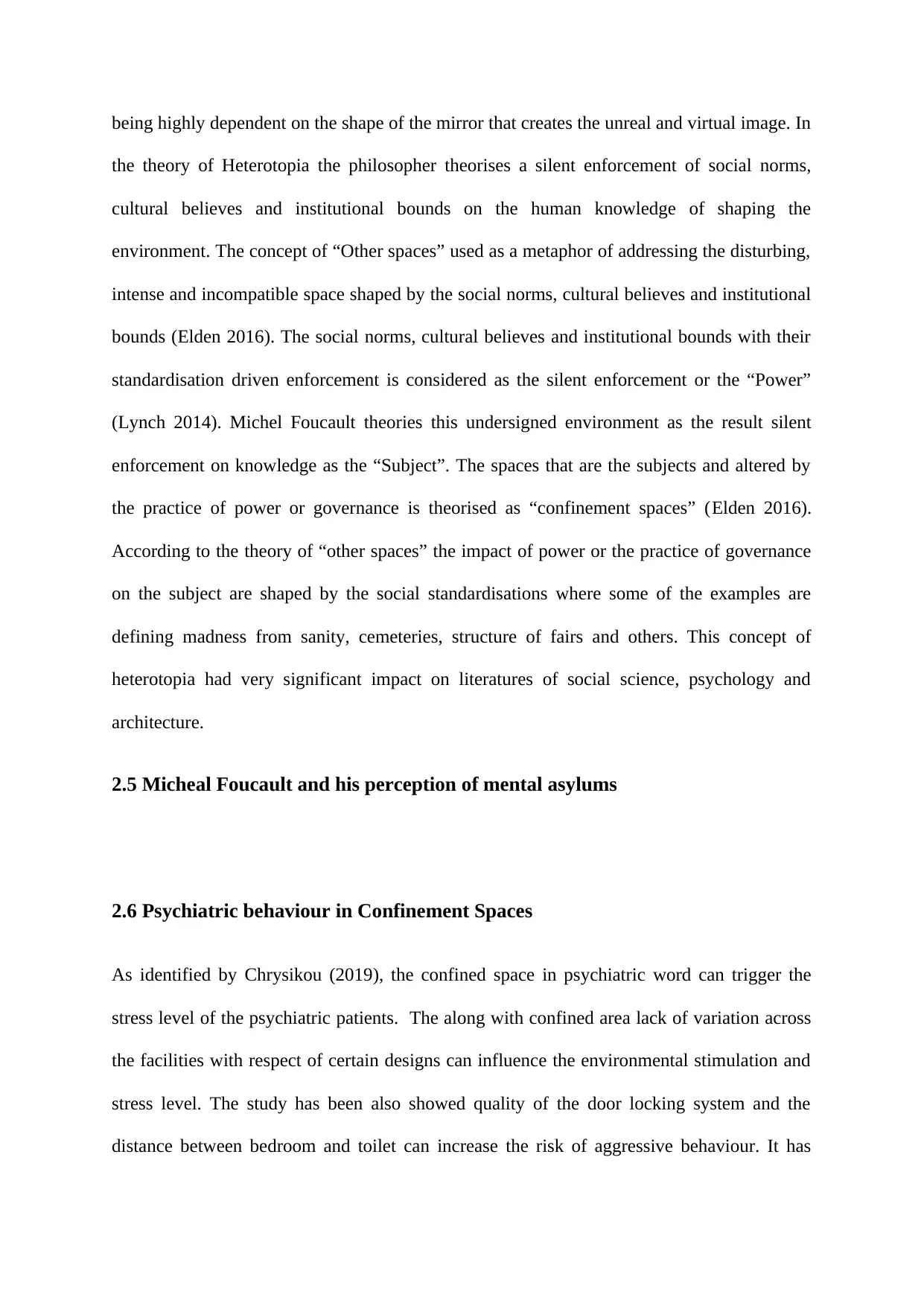
being highly dependent on the shape of the mirror that creates the unreal and virtual image. In
the theory of Heterotopia the philosopher theorises a silent enforcement of social norms,
cultural believes and institutional bounds on the human knowledge of shaping the
environment. The concept of “Other spaces” used as a metaphor of addressing the disturbing,
intense and incompatible space shaped by the social norms, cultural believes and institutional
bounds (Elden 2016). The social norms, cultural believes and institutional bounds with their
standardisation driven enforcement is considered as the silent enforcement or the “Power”
(Lynch 2014). Michel Foucault theories this undersigned environment as the result silent
enforcement on knowledge as the “Subject”. The spaces that are the subjects and altered by
the practice of power or governance is theorised as “confinement spaces” (Elden 2016).
According to the theory of “other spaces” the impact of power or the practice of governance
on the subject are shaped by the social standardisations where some of the examples are
defining madness from sanity, cemeteries, structure of fairs and others. This concept of
heterotopia had very significant impact on literatures of social science, psychology and
architecture.
2.5 Micheal Foucault and his perception of mental asylums
2.6 Psychiatric behaviour in Confinement Spaces
As identified by Chrysikou (2019), the confined space in psychiatric word can trigger the
stress level of the psychiatric patients. The along with confined area lack of variation across
the facilities with respect of certain designs can influence the environmental stimulation and
stress level. The study has been also showed quality of the door locking system and the
distance between bedroom and toilet can increase the risk of aggressive behaviour. It has
the theory of Heterotopia the philosopher theorises a silent enforcement of social norms,
cultural believes and institutional bounds on the human knowledge of shaping the
environment. The concept of “Other spaces” used as a metaphor of addressing the disturbing,
intense and incompatible space shaped by the social norms, cultural believes and institutional
bounds (Elden 2016). The social norms, cultural believes and institutional bounds with their
standardisation driven enforcement is considered as the silent enforcement or the “Power”
(Lynch 2014). Michel Foucault theories this undersigned environment as the result silent
enforcement on knowledge as the “Subject”. The spaces that are the subjects and altered by
the practice of power or governance is theorised as “confinement spaces” (Elden 2016).
According to the theory of “other spaces” the impact of power or the practice of governance
on the subject are shaped by the social standardisations where some of the examples are
defining madness from sanity, cemeteries, structure of fairs and others. This concept of
heterotopia had very significant impact on literatures of social science, psychology and
architecture.
2.5 Micheal Foucault and his perception of mental asylums
2.6 Psychiatric behaviour in Confinement Spaces
As identified by Chrysikou (2019), the confined space in psychiatric word can trigger the
stress level of the psychiatric patients. The along with confined area lack of variation across
the facilities with respect of certain designs can influence the environmental stimulation and
stress level. The study has been also showed quality of the door locking system and the
distance between bedroom and toilet can increase the risk of aggressive behaviour. It has
Secure Best Marks with AI Grader
Need help grading? Try our AI Grader for instant feedback on your assignments.
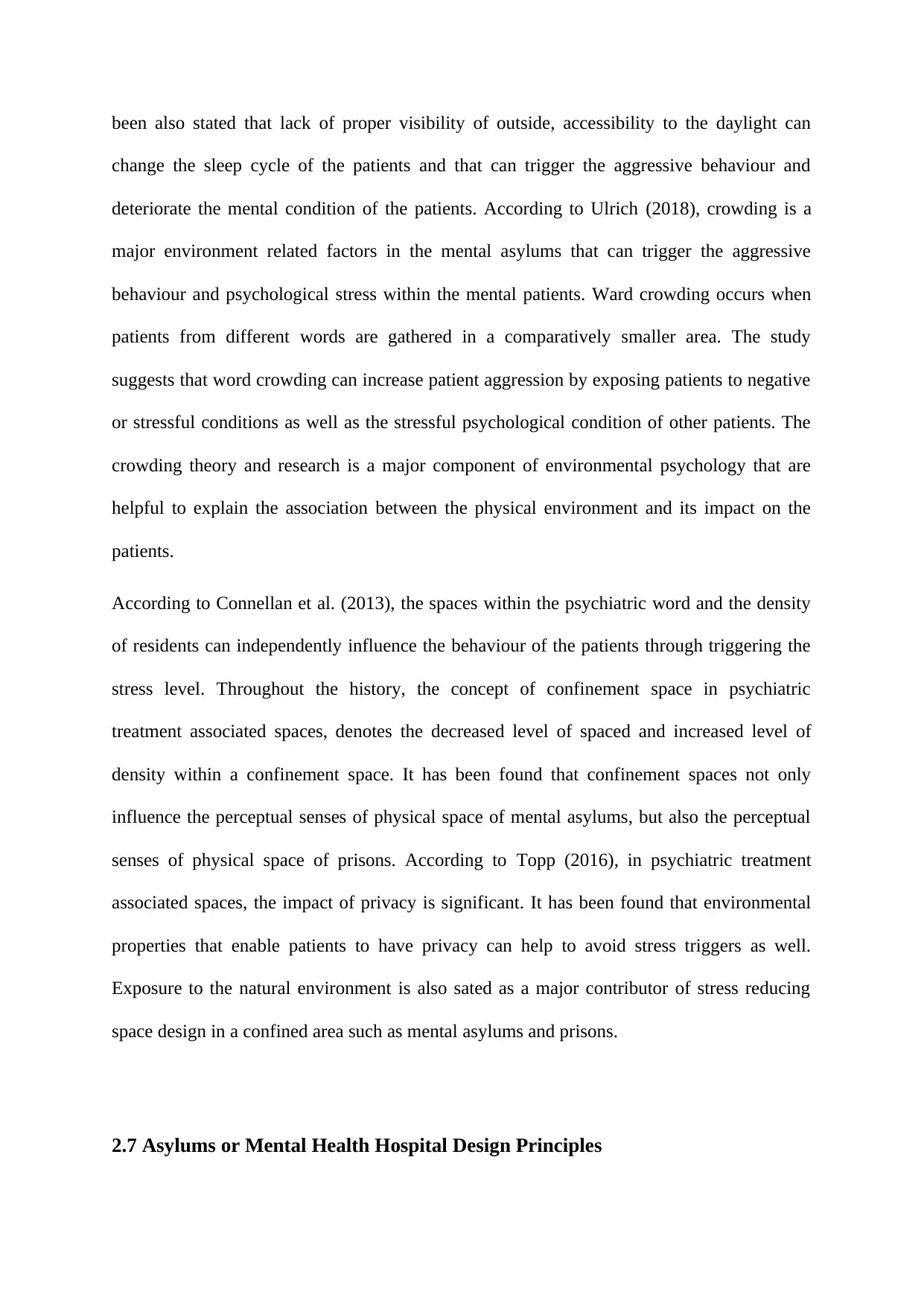
been also stated that lack of proper visibility of outside, accessibility to the daylight can
change the sleep cycle of the patients and that can trigger the aggressive behaviour and
deteriorate the mental condition of the patients. According to Ulrich (2018), crowding is a
major environment related factors in the mental asylums that can trigger the aggressive
behaviour and psychological stress within the mental patients. Ward crowding occurs when
patients from different words are gathered in a comparatively smaller area. The study
suggests that word crowding can increase patient aggression by exposing patients to negative
or stressful conditions as well as the stressful psychological condition of other patients. The
crowding theory and research is a major component of environmental psychology that are
helpful to explain the association between the physical environment and its impact on the
patients.
According to Connellan et al. (2013), the spaces within the psychiatric word and the density
of residents can independently influence the behaviour of the patients through triggering the
stress level. Throughout the history, the concept of confinement space in psychiatric
treatment associated spaces, denotes the decreased level of spaced and increased level of
density within a confinement space. It has been found that confinement spaces not only
influence the perceptual senses of physical space of mental asylums, but also the perceptual
senses of physical space of prisons. According to Topp (2016), in psychiatric treatment
associated spaces, the impact of privacy is significant. It has been found that environmental
properties that enable patients to have privacy can help to avoid stress triggers as well.
Exposure to the natural environment is also sated as a major contributor of stress reducing
space design in a confined area such as mental asylums and prisons.
2.7 Asylums or Mental Health Hospital Design Principles
change the sleep cycle of the patients and that can trigger the aggressive behaviour and
deteriorate the mental condition of the patients. According to Ulrich (2018), crowding is a
major environment related factors in the mental asylums that can trigger the aggressive
behaviour and psychological stress within the mental patients. Ward crowding occurs when
patients from different words are gathered in a comparatively smaller area. The study
suggests that word crowding can increase patient aggression by exposing patients to negative
or stressful conditions as well as the stressful psychological condition of other patients. The
crowding theory and research is a major component of environmental psychology that are
helpful to explain the association between the physical environment and its impact on the
patients.
According to Connellan et al. (2013), the spaces within the psychiatric word and the density
of residents can independently influence the behaviour of the patients through triggering the
stress level. Throughout the history, the concept of confinement space in psychiatric
treatment associated spaces, denotes the decreased level of spaced and increased level of
density within a confinement space. It has been found that confinement spaces not only
influence the perceptual senses of physical space of mental asylums, but also the perceptual
senses of physical space of prisons. According to Topp (2016), in psychiatric treatment
associated spaces, the impact of privacy is significant. It has been found that environmental
properties that enable patients to have privacy can help to avoid stress triggers as well.
Exposure to the natural environment is also sated as a major contributor of stress reducing
space design in a confined area such as mental asylums and prisons.
2.7 Asylums or Mental Health Hospital Design Principles
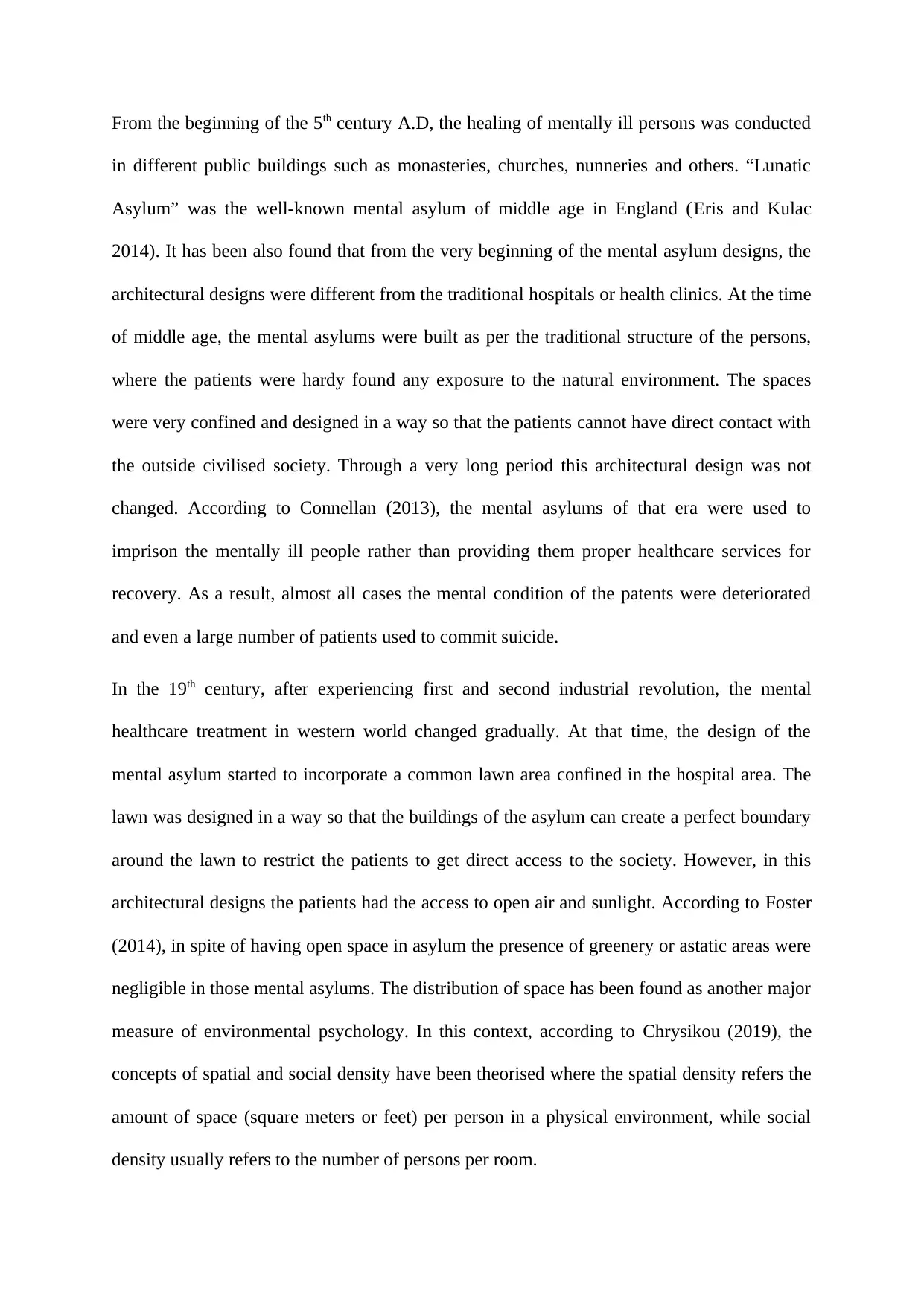
From the beginning of the 5th century A.D, the healing of mentally ill persons was conducted
in different public buildings such as monasteries, churches, nunneries and others. “Lunatic
Asylum” was the well-known mental asylum of middle age in England (Eris and Kulac
2014). It has been also found that from the very beginning of the mental asylum designs, the
architectural designs were different from the traditional hospitals or health clinics. At the time
of middle age, the mental asylums were built as per the traditional structure of the persons,
where the patients were hardy found any exposure to the natural environment. The spaces
were very confined and designed in a way so that the patients cannot have direct contact with
the outside civilised society. Through a very long period this architectural design was not
changed. According to Connellan (2013), the mental asylums of that era were used to
imprison the mentally ill people rather than providing them proper healthcare services for
recovery. As a result, almost all cases the mental condition of the patents were deteriorated
and even a large number of patients used to commit suicide.
In the 19th century, after experiencing first and second industrial revolution, the mental
healthcare treatment in western world changed gradually. At that time, the design of the
mental asylum started to incorporate a common lawn area confined in the hospital area. The
lawn was designed in a way so that the buildings of the asylum can create a perfect boundary
around the lawn to restrict the patients to get direct access to the society. However, in this
architectural designs the patients had the access to open air and sunlight. According to Foster
(2014), in spite of having open space in asylum the presence of greenery or astatic areas were
negligible in those mental asylums. The distribution of space has been found as another major
measure of environmental psychology. In this context, according to Chrysikou (2019), the
concepts of spatial and social density have been theorised where the spatial density refers the
amount of space (square meters or feet) per person in a physical environment, while social
density usually refers to the number of persons per room.
in different public buildings such as monasteries, churches, nunneries and others. “Lunatic
Asylum” was the well-known mental asylum of middle age in England (Eris and Kulac
2014). It has been also found that from the very beginning of the mental asylum designs, the
architectural designs were different from the traditional hospitals or health clinics. At the time
of middle age, the mental asylums were built as per the traditional structure of the persons,
where the patients were hardy found any exposure to the natural environment. The spaces
were very confined and designed in a way so that the patients cannot have direct contact with
the outside civilised society. Through a very long period this architectural design was not
changed. According to Connellan (2013), the mental asylums of that era were used to
imprison the mentally ill people rather than providing them proper healthcare services for
recovery. As a result, almost all cases the mental condition of the patents were deteriorated
and even a large number of patients used to commit suicide.
In the 19th century, after experiencing first and second industrial revolution, the mental
healthcare treatment in western world changed gradually. At that time, the design of the
mental asylum started to incorporate a common lawn area confined in the hospital area. The
lawn was designed in a way so that the buildings of the asylum can create a perfect boundary
around the lawn to restrict the patients to get direct access to the society. However, in this
architectural designs the patients had the access to open air and sunlight. According to Foster
(2014), in spite of having open space in asylum the presence of greenery or astatic areas were
negligible in those mental asylums. The distribution of space has been found as another major
measure of environmental psychology. In this context, according to Chrysikou (2019), the
concepts of spatial and social density have been theorised where the spatial density refers the
amount of space (square meters or feet) per person in a physical environment, while social
density usually refers to the number of persons per room.
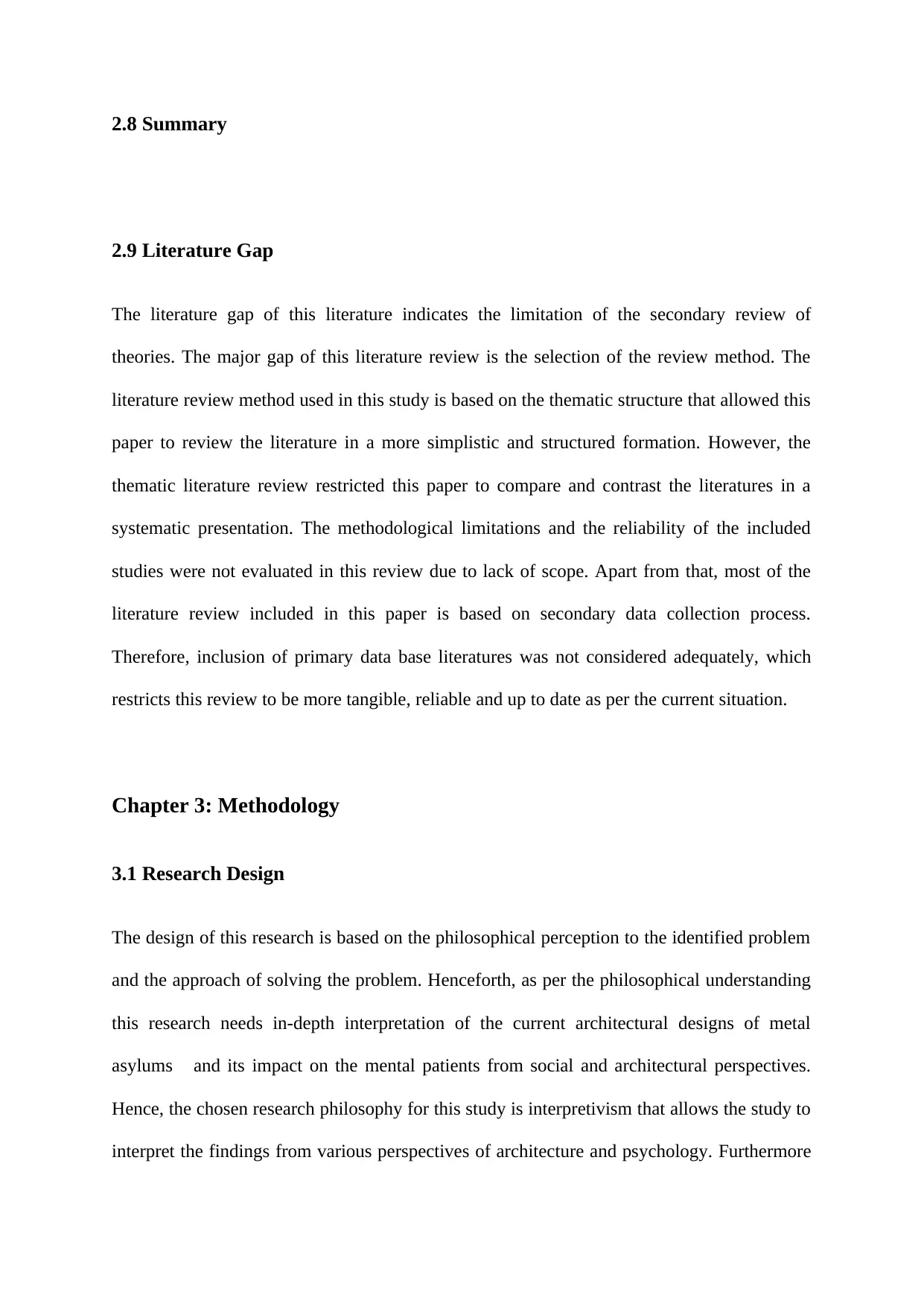
2.8 Summary
2.9 Literature Gap
The literature gap of this literature indicates the limitation of the secondary review of
theories. The major gap of this literature review is the selection of the review method. The
literature review method used in this study is based on the thematic structure that allowed this
paper to review the literature in a more simplistic and structured formation. However, the
thematic literature review restricted this paper to compare and contrast the literatures in a
systematic presentation. The methodological limitations and the reliability of the included
studies were not evaluated in this review due to lack of scope. Apart from that, most of the
literature review included in this paper is based on secondary data collection process.
Therefore, inclusion of primary data base literatures was not considered adequately, which
restricts this review to be more tangible, reliable and up to date as per the current situation.
Chapter 3: Methodology
3.1 Research Design
The design of this research is based on the philosophical perception to the identified problem
and the approach of solving the problem. Henceforth, as per the philosophical understanding
this research needs in-depth interpretation of the current architectural designs of metal
asylums and its impact on the mental patients from social and architectural perspectives.
Hence, the chosen research philosophy for this study is interpretivism that allows the study to
interpret the findings from various perspectives of architecture and psychology. Furthermore
2.9 Literature Gap
The literature gap of this literature indicates the limitation of the secondary review of
theories. The major gap of this literature review is the selection of the review method. The
literature review method used in this study is based on the thematic structure that allowed this
paper to review the literature in a more simplistic and structured formation. However, the
thematic literature review restricted this paper to compare and contrast the literatures in a
systematic presentation. The methodological limitations and the reliability of the included
studies were not evaluated in this review due to lack of scope. Apart from that, most of the
literature review included in this paper is based on secondary data collection process.
Therefore, inclusion of primary data base literatures was not considered adequately, which
restricts this review to be more tangible, reliable and up to date as per the current situation.
Chapter 3: Methodology
3.1 Research Design
The design of this research is based on the philosophical perception to the identified problem
and the approach of solving the problem. Henceforth, as per the philosophical understanding
this research needs in-depth interpretation of the current architectural designs of metal
asylums and its impact on the mental patients from social and architectural perspectives.
Hence, the chosen research philosophy for this study is interpretivism that allows the study to
interpret the findings from various perspectives of architecture and psychology. Furthermore
Paraphrase This Document
Need a fresh take? Get an instant paraphrase of this document with our AI Paraphraser
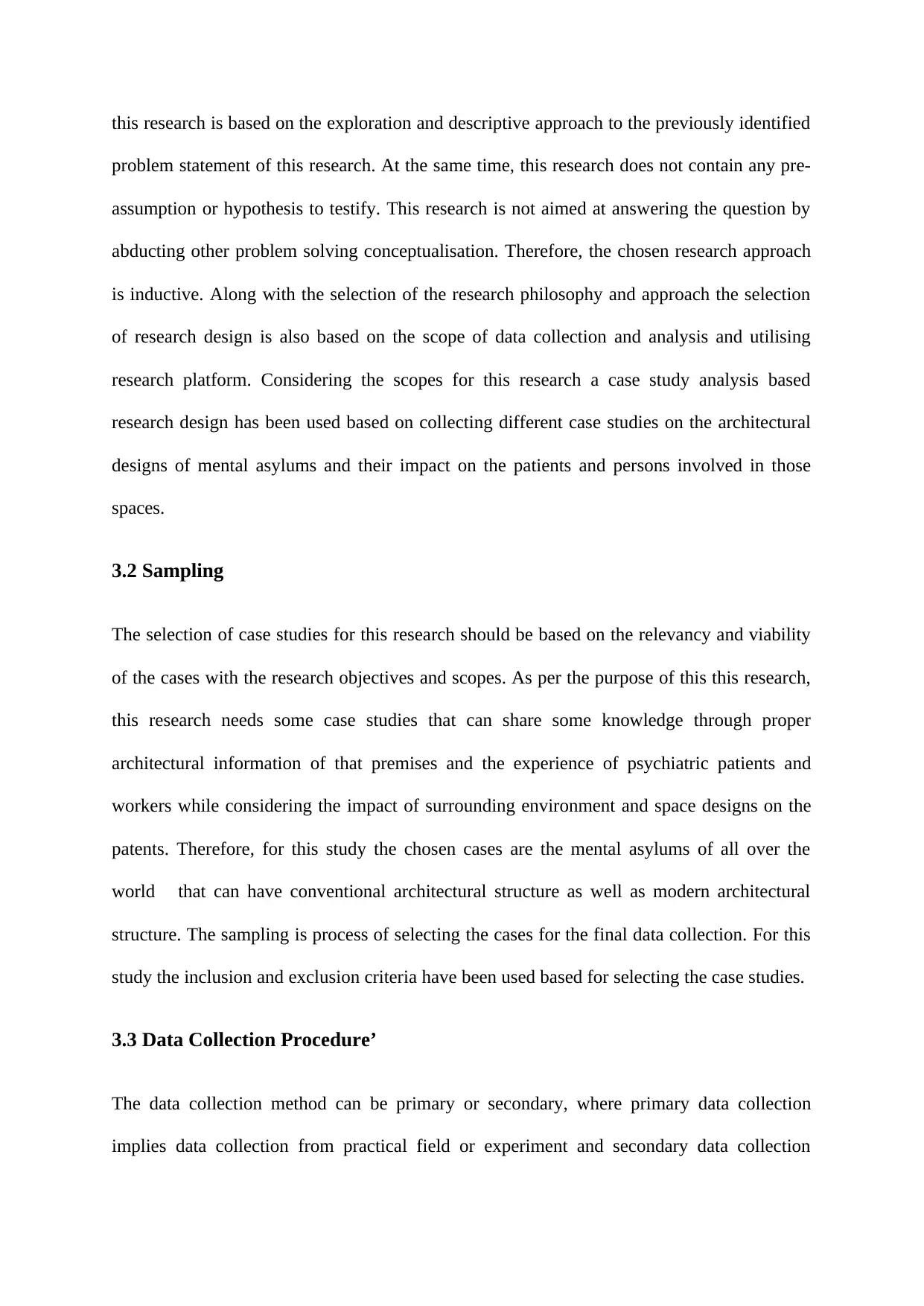
this research is based on the exploration and descriptive approach to the previously identified
problem statement of this research. At the same time, this research does not contain any pre-
assumption or hypothesis to testify. This research is not aimed at answering the question by
abducting other problem solving conceptualisation. Therefore, the chosen research approach
is inductive. Along with the selection of the research philosophy and approach the selection
of research design is also based on the scope of data collection and analysis and utilising
research platform. Considering the scopes for this research a case study analysis based
research design has been used based on collecting different case studies on the architectural
designs of mental asylums and their impact on the patients and persons involved in those
spaces.
3.2 Sampling
The selection of case studies for this research should be based on the relevancy and viability
of the cases with the research objectives and scopes. As per the purpose of this this research,
this research needs some case studies that can share some knowledge through proper
architectural information of that premises and the experience of psychiatric patients and
workers while considering the impact of surrounding environment and space designs on the
patents. Therefore, for this study the chosen cases are the mental asylums of all over the
world that can have conventional architectural structure as well as modern architectural
structure. The sampling is process of selecting the cases for the final data collection. For this
study the inclusion and exclusion criteria have been used based for selecting the case studies.
3.3 Data Collection Procedure’
The data collection method can be primary or secondary, where primary data collection
implies data collection from practical field or experiment and secondary data collection
problem statement of this research. At the same time, this research does not contain any pre-
assumption or hypothesis to testify. This research is not aimed at answering the question by
abducting other problem solving conceptualisation. Therefore, the chosen research approach
is inductive. Along with the selection of the research philosophy and approach the selection
of research design is also based on the scope of data collection and analysis and utilising
research platform. Considering the scopes for this research a case study analysis based
research design has been used based on collecting different case studies on the architectural
designs of mental asylums and their impact on the patients and persons involved in those
spaces.
3.2 Sampling
The selection of case studies for this research should be based on the relevancy and viability
of the cases with the research objectives and scopes. As per the purpose of this this research,
this research needs some case studies that can share some knowledge through proper
architectural information of that premises and the experience of psychiatric patients and
workers while considering the impact of surrounding environment and space designs on the
patents. Therefore, for this study the chosen cases are the mental asylums of all over the
world that can have conventional architectural structure as well as modern architectural
structure. The sampling is process of selecting the cases for the final data collection. For this
study the inclusion and exclusion criteria have been used based for selecting the case studies.
3.3 Data Collection Procedure’
The data collection method can be primary or secondary, where primary data collection
implies data collection from practical field or experiment and secondary data collection
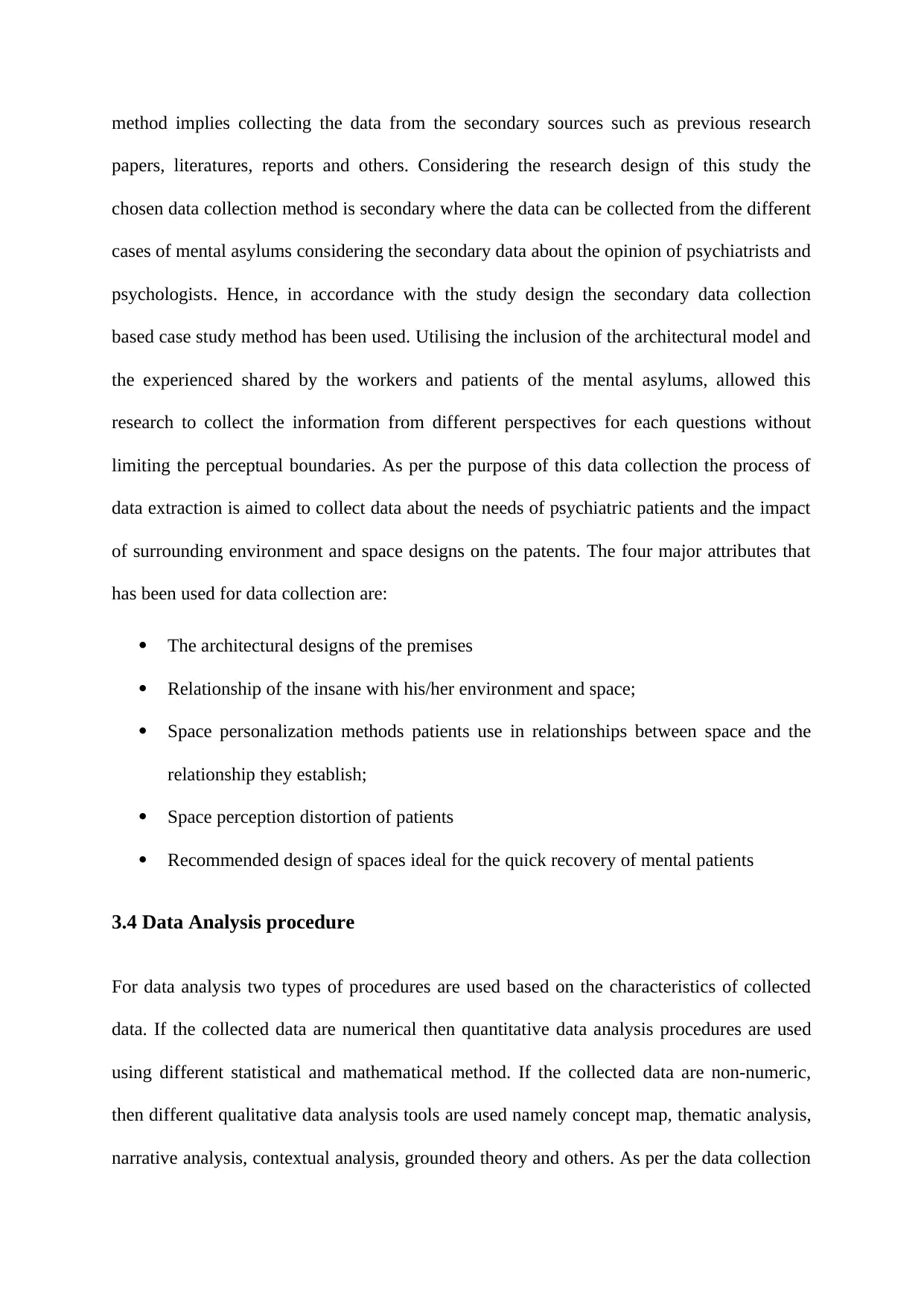
method implies collecting the data from the secondary sources such as previous research
papers, literatures, reports and others. Considering the research design of this study the
chosen data collection method is secondary where the data can be collected from the different
cases of mental asylums considering the secondary data about the opinion of psychiatrists and
psychologists. Hence, in accordance with the study design the secondary data collection
based case study method has been used. Utilising the inclusion of the architectural model and
the experienced shared by the workers and patients of the mental asylums, allowed this
research to collect the information from different perspectives for each questions without
limiting the perceptual boundaries. As per the purpose of this data collection the process of
data extraction is aimed to collect data about the needs of psychiatric patients and the impact
of surrounding environment and space designs on the patents. The four major attributes that
has been used for data collection are:
The architectural designs of the premises
Relationship of the insane with his/her environment and space;
Space personalization methods patients use in relationships between space and the
relationship they establish;
Space perception distortion of patients
Recommended design of spaces ideal for the quick recovery of mental patients
3.4 Data Analysis procedure
For data analysis two types of procedures are used based on the characteristics of collected
data. If the collected data are numerical then quantitative data analysis procedures are used
using different statistical and mathematical method. If the collected data are non-numeric,
then different qualitative data analysis tools are used namely concept map, thematic analysis,
narrative analysis, contextual analysis, grounded theory and others. As per the data collection
papers, literatures, reports and others. Considering the research design of this study the
chosen data collection method is secondary where the data can be collected from the different
cases of mental asylums considering the secondary data about the opinion of psychiatrists and
psychologists. Hence, in accordance with the study design the secondary data collection
based case study method has been used. Utilising the inclusion of the architectural model and
the experienced shared by the workers and patients of the mental asylums, allowed this
research to collect the information from different perspectives for each questions without
limiting the perceptual boundaries. As per the purpose of this data collection the process of
data extraction is aimed to collect data about the needs of psychiatric patients and the impact
of surrounding environment and space designs on the patents. The four major attributes that
has been used for data collection are:
The architectural designs of the premises
Relationship of the insane with his/her environment and space;
Space personalization methods patients use in relationships between space and the
relationship they establish;
Space perception distortion of patients
Recommended design of spaces ideal for the quick recovery of mental patients
3.4 Data Analysis procedure
For data analysis two types of procedures are used based on the characteristics of collected
data. If the collected data are numerical then quantitative data analysis procedures are used
using different statistical and mathematical method. If the collected data are non-numeric,
then different qualitative data analysis tools are used namely concept map, thematic analysis,
narrative analysis, contextual analysis, grounded theory and others. As per the data collection
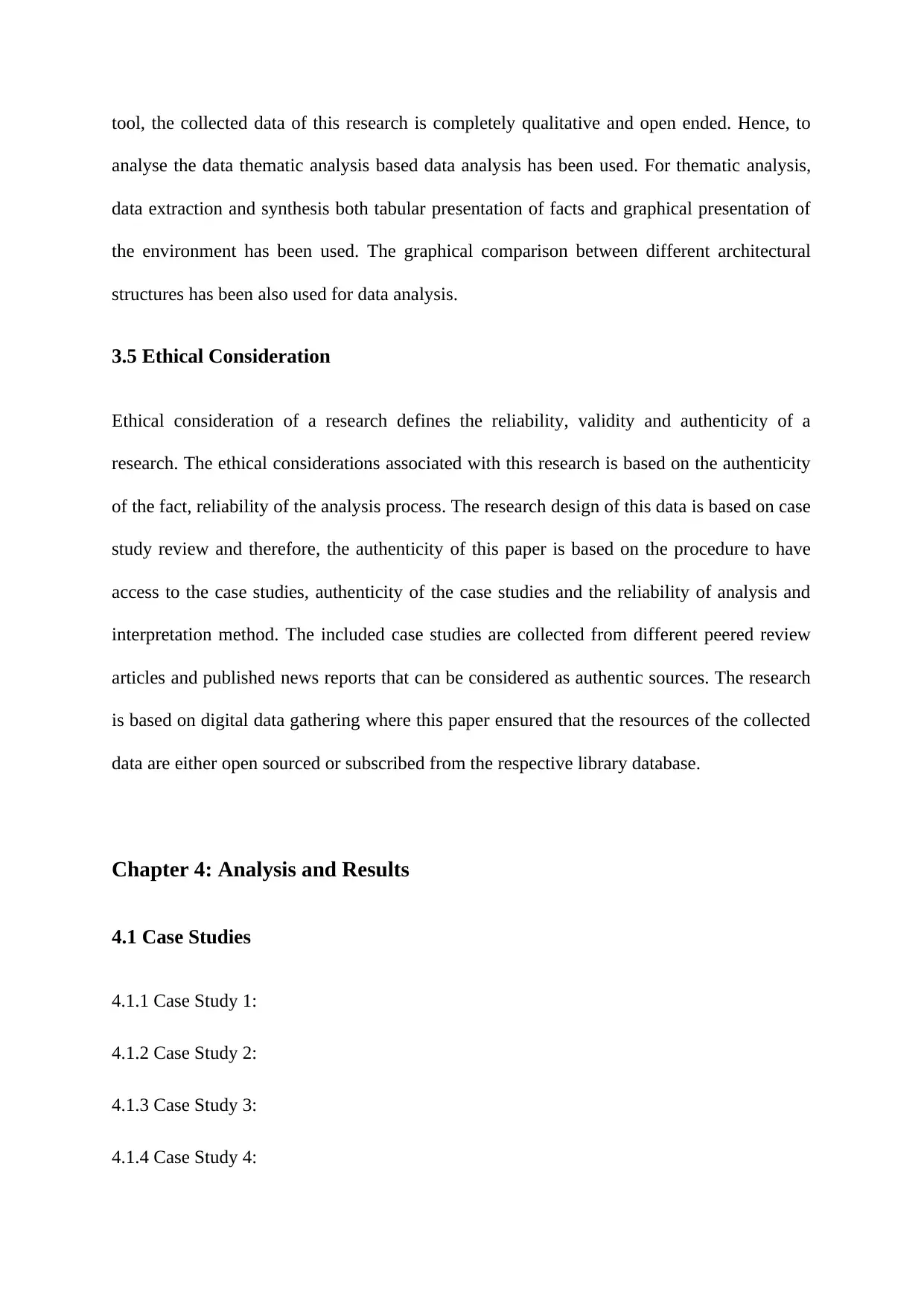
tool, the collected data of this research is completely qualitative and open ended. Hence, to
analyse the data thematic analysis based data analysis has been used. For thematic analysis,
data extraction and synthesis both tabular presentation of facts and graphical presentation of
the environment has been used. The graphical comparison between different architectural
structures has been also used for data analysis.
3.5 Ethical Consideration
Ethical consideration of a research defines the reliability, validity and authenticity of a
research. The ethical considerations associated with this research is based on the authenticity
of the fact, reliability of the analysis process. The research design of this data is based on case
study review and therefore, the authenticity of this paper is based on the procedure to have
access to the case studies, authenticity of the case studies and the reliability of analysis and
interpretation method. The included case studies are collected from different peered review
articles and published news reports that can be considered as authentic sources. The research
is based on digital data gathering where this paper ensured that the resources of the collected
data are either open sourced or subscribed from the respective library database.
Chapter 4: Analysis and Results
4.1 Case Studies
4.1.1 Case Study 1:
4.1.2 Case Study 2:
4.1.3 Case Study 3:
4.1.4 Case Study 4:
analyse the data thematic analysis based data analysis has been used. For thematic analysis,
data extraction and synthesis both tabular presentation of facts and graphical presentation of
the environment has been used. The graphical comparison between different architectural
structures has been also used for data analysis.
3.5 Ethical Consideration
Ethical consideration of a research defines the reliability, validity and authenticity of a
research. The ethical considerations associated with this research is based on the authenticity
of the fact, reliability of the analysis process. The research design of this data is based on case
study review and therefore, the authenticity of this paper is based on the procedure to have
access to the case studies, authenticity of the case studies and the reliability of analysis and
interpretation method. The included case studies are collected from different peered review
articles and published news reports that can be considered as authentic sources. The research
is based on digital data gathering where this paper ensured that the resources of the collected
data are either open sourced or subscribed from the respective library database.
Chapter 4: Analysis and Results
4.1 Case Studies
4.1.1 Case Study 1:
4.1.2 Case Study 2:
4.1.3 Case Study 3:
4.1.4 Case Study 4:
Secure Best Marks with AI Grader
Need help grading? Try our AI Grader for instant feedback on your assignments.
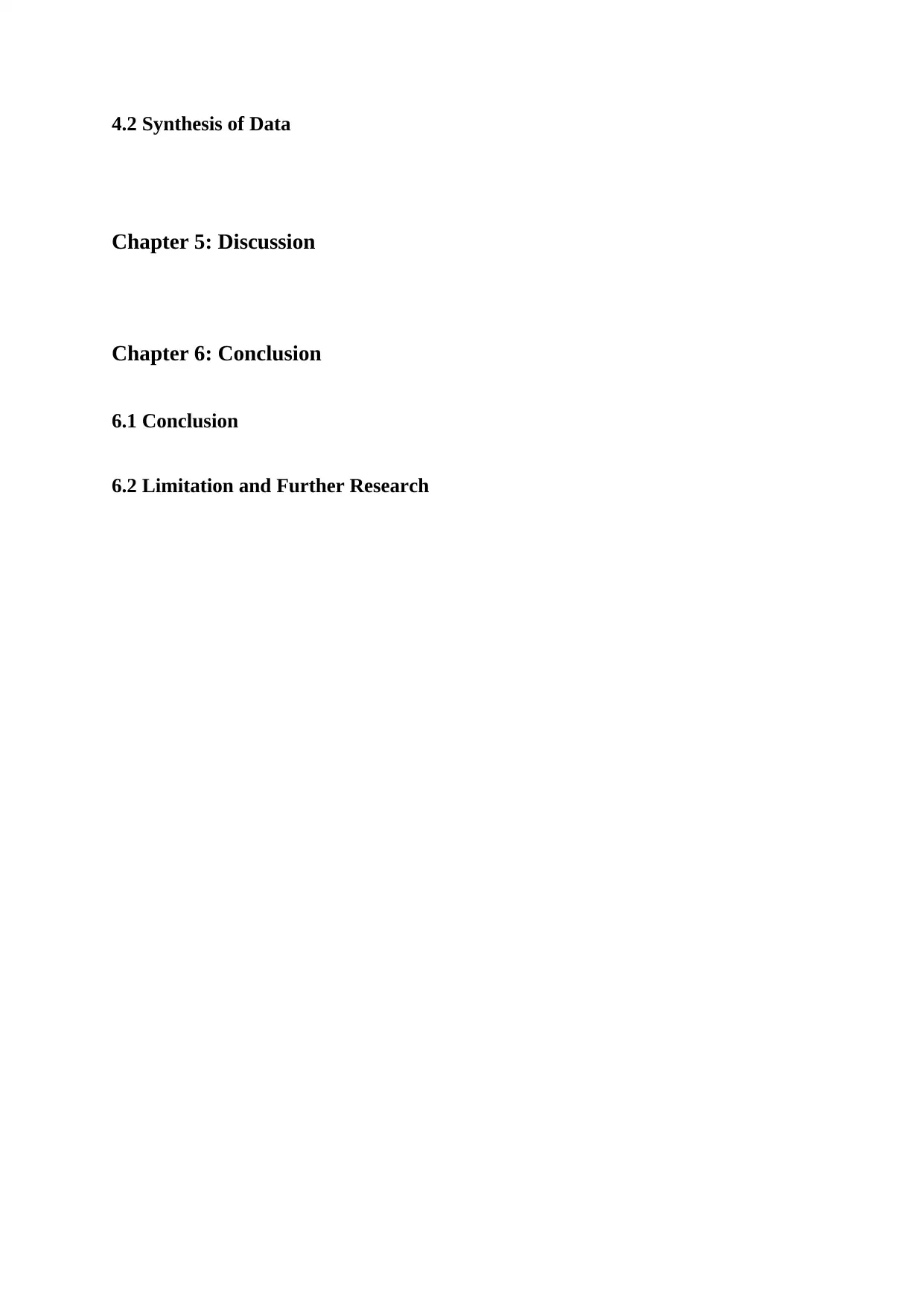
4.2 Synthesis of Data
Chapter 5: Discussion
Chapter 6: Conclusion
6.1 Conclusion
6.2 Limitation and Further Research
Chapter 5: Discussion
Chapter 6: Conclusion
6.1 Conclusion
6.2 Limitation and Further Research
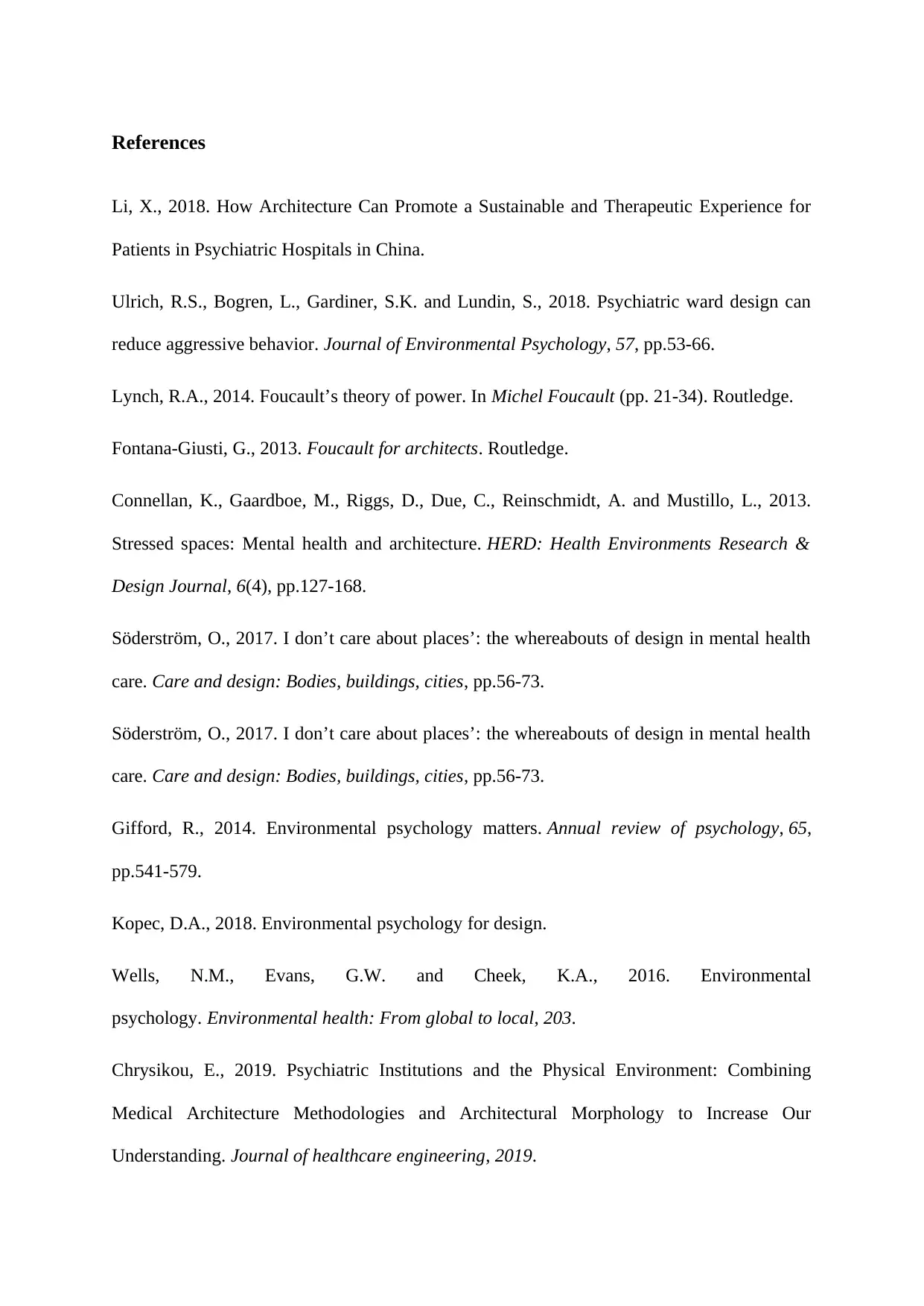
References
Li, X., 2018. How Architecture Can Promote a Sustainable and Therapeutic Experience for
Patients in Psychiatric Hospitals in China.
Ulrich, R.S., Bogren, L., Gardiner, S.K. and Lundin, S., 2018. Psychiatric ward design can
reduce aggressive behavior. Journal of Environmental Psychology, 57, pp.53-66.
Lynch, R.A., 2014. Foucault’s theory of power. In Michel Foucault (pp. 21-34). Routledge.
Fontana-Giusti, G., 2013. Foucault for architects. Routledge.
Connellan, K., Gaardboe, M., Riggs, D., Due, C., Reinschmidt, A. and Mustillo, L., 2013.
Stressed spaces: Mental health and architecture. HERD: Health Environments Research &
Design Journal, 6(4), pp.127-168.
Söderström, O., 2017. I don’t care about places’: the whereabouts of design in mental health
care. Care and design: Bodies, buildings, cities, pp.56-73.
Söderström, O., 2017. I don’t care about places’: the whereabouts of design in mental health
care. Care and design: Bodies, buildings, cities, pp.56-73.
Gifford, R., 2014. Environmental psychology matters. Annual review of psychology, 65,
pp.541-579.
Kopec, D.A., 2018. Environmental psychology for design.
Wells, N.M., Evans, G.W. and Cheek, K.A., 2016. Environmental
psychology. Environmental health: From global to local, 203.
Chrysikou, E., 2019. Psychiatric Institutions and the Physical Environment: Combining
Medical Architecture Methodologies and Architectural Morphology to Increase Our
Understanding. Journal of healthcare engineering, 2019.
Li, X., 2018. How Architecture Can Promote a Sustainable and Therapeutic Experience for
Patients in Psychiatric Hospitals in China.
Ulrich, R.S., Bogren, L., Gardiner, S.K. and Lundin, S., 2018. Psychiatric ward design can
reduce aggressive behavior. Journal of Environmental Psychology, 57, pp.53-66.
Lynch, R.A., 2014. Foucault’s theory of power. In Michel Foucault (pp. 21-34). Routledge.
Fontana-Giusti, G., 2013. Foucault for architects. Routledge.
Connellan, K., Gaardboe, M., Riggs, D., Due, C., Reinschmidt, A. and Mustillo, L., 2013.
Stressed spaces: Mental health and architecture. HERD: Health Environments Research &
Design Journal, 6(4), pp.127-168.
Söderström, O., 2017. I don’t care about places’: the whereabouts of design in mental health
care. Care and design: Bodies, buildings, cities, pp.56-73.
Söderström, O., 2017. I don’t care about places’: the whereabouts of design in mental health
care. Care and design: Bodies, buildings, cities, pp.56-73.
Gifford, R., 2014. Environmental psychology matters. Annual review of psychology, 65,
pp.541-579.
Kopec, D.A., 2018. Environmental psychology for design.
Wells, N.M., Evans, G.W. and Cheek, K.A., 2016. Environmental
psychology. Environmental health: From global to local, 203.
Chrysikou, E., 2019. Psychiatric Institutions and the Physical Environment: Combining
Medical Architecture Methodologies and Architectural Morphology to Increase Our
Understanding. Journal of healthcare engineering, 2019.
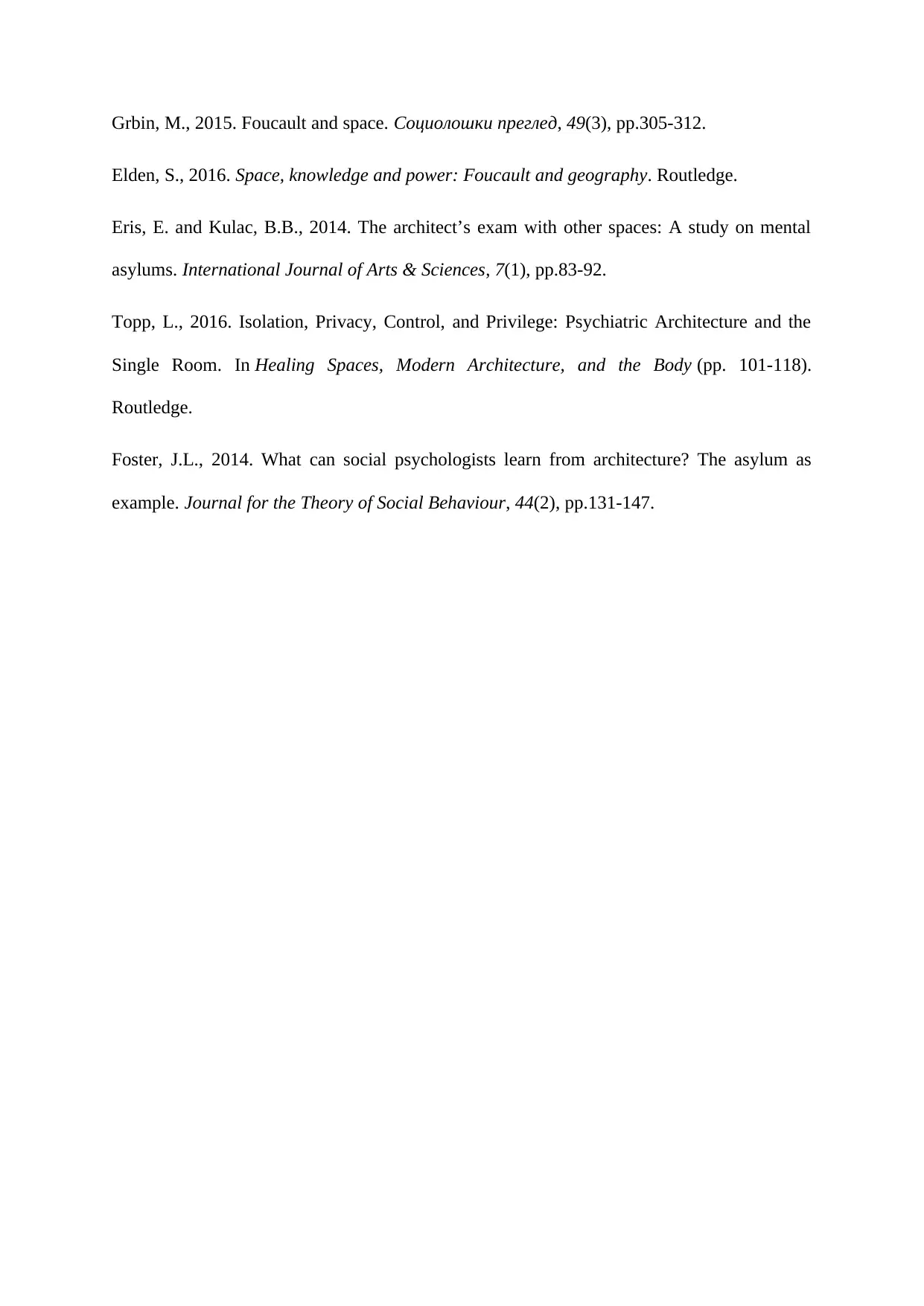
Grbin, M., 2015. Foucault and space. Социолошки преглед, 49(3), pp.305-312.
Elden, S., 2016. Space, knowledge and power: Foucault and geography. Routledge.
Eris, E. and Kulac, B.B., 2014. The architect’s exam with other spaces: A study on mental
asylums. International Journal of Arts & Sciences, 7(1), pp.83-92.
Topp, L., 2016. Isolation, Privacy, Control, and Privilege: Psychiatric Architecture and the
Single Room. In Healing Spaces, Modern Architecture, and the Body (pp. 101-118).
Routledge.
Foster, J.L., 2014. What can social psychologists learn from architecture? The asylum as
example. Journal for the Theory of Social Behaviour, 44(2), pp.131-147.
Elden, S., 2016. Space, knowledge and power: Foucault and geography. Routledge.
Eris, E. and Kulac, B.B., 2014. The architect’s exam with other spaces: A study on mental
asylums. International Journal of Arts & Sciences, 7(1), pp.83-92.
Topp, L., 2016. Isolation, Privacy, Control, and Privilege: Psychiatric Architecture and the
Single Room. In Healing Spaces, Modern Architecture, and the Body (pp. 101-118).
Routledge.
Foster, J.L., 2014. What can social psychologists learn from architecture? The asylum as
example. Journal for the Theory of Social Behaviour, 44(2), pp.131-147.
1 out of 19
Your All-in-One AI-Powered Toolkit for Academic Success.
+13062052269
info@desklib.com
Available 24*7 on WhatsApp / Email
![[object Object]](/_next/static/media/star-bottom.7253800d.svg)
Unlock your academic potential
© 2024 | Zucol Services PVT LTD | All rights reserved.